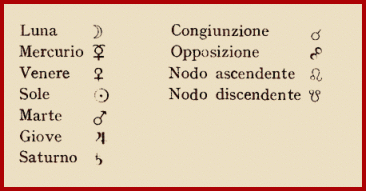Guido Horn d'Arturo (continued)
Research
|
Horn d'Arturo's research covered various fields of astronomy, astrophysics and cosmology, from historic topics (see his work on Arabic numbers and celestial symbols) to optics and astronomic instrumentation. An overview of his extensive published works can be found in his bibliography, while described below is his research into the "black drop" and "flying shadows".
|
 Fig. 1: Symbols used in astronomy to indicate planets, Sun, Moon and other phenomena. (Credit: Pubblicazioni dell'Osservatorio Astronomico della R. UniversitÓ di Bologna", I, 7, 1925) |
The "black drop" is an optical phenomenon, visible especially during the very rare transits of Venus on the Sun when the shadow of the planet comes into contact with the edges of the solar disc.
 |
|
| Fig. 2:
Images
of the "black drop" as it makes contact between the shadow of Venus and
the edge of the Sun. (Credit: "Pubblicazioni dell'Osservatorio astronomico della R. UniversitÓ di Bologna", I, 3, 1922) |
In 1926, Horn d'Arturo led an Italian expedition to Somalia to observe the total eclipse of the sun. On this occasion he wrote an article on the "flying shadows" which precede and follow the eclipses in alternating light and dark bands. His ideas were confirmed thirty years later by studies into stellar scintillation carried out at the Perkins Observatory in the USA.
As soon as Horn d'Arturo arrived in Bologna he founded the Pubblicazioni dell'Osservatorio astronomico universitario, publications which detailed his university research work. These Pubblicazioni were sent to Observatories all round the world, promoting the astronomic activities of Bologna University, and the books and journals which arrived in exchange enriched the Library, which is now named after Guido Horn d'Arturo. The letters exchanged between scientists worldwide are also preserved in the archives.
|
|
